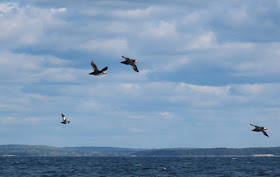 |
| Puffins! |
When Project Puffin began, all the puffins nesting along the Maine coast were on just two islands- Matinicus Rock and Machias Seal Island on the U.S./Canadian border. The two surviving colonies were vulnerable to a disaster such as an oil spill, or accidental invasion of predators such as rats or mink. Although puffins are not an endangered species (millions still nest in Newfoundland, Iceland, and Britain), they are rare in Maine and are listed by the state as a threatened species. Despite their large numbers in Europe, recent declines in populations and nesting success have led to them receiving world status of Threatened and Endangered in Europe by the International Union for Conservation of Nature (IUCN).
Project Puffin began with an attempt to restore puffins to Eastern Egg Rock in Muscongus Bay (near Hog Island), about six miles east of Pemaquid Point. Puffins had nested there until about 1885 when hunters took the last survivors of this once-flourishing colony. The restoration of puffins to Eastern Egg Rock is based on the fact that young puffins usually return to breed on the same island where they hatched. Young puffins from Great Island, Newfoundland (where about 160,000 pairs nest) were transplanted to Eastern Egg Rock when they were about 10 - 14 days old. The young puffins were then reared in artificial sod burrows for about one month. Audubon biologists placed handfuls of vitamin-fortified fish in their burrows each day and, in effect, took the place of parent puffins. I asked about imprinting, and the chicks never really saw the researchers who fed them. As our boat approached, many Puffins flew around to check us out.
As the young puffins reached fledging age (the time when birds leave the nest), they received leg bands so they could be recognized in the future. After spending their first 2-3 years at sea, it was hoped they would return to establish a new colony at Eastern Egg Rock rather than Great Island. Because this was the first time an attempt had been made to restore a puffin colony, the outcome was unknown. Between 1973 and 1986, 954 young puffins were transplanted from Great Island to Eastern Egg Rock and 914 of these successfully fledged.
Transplanted puffins began returning to Eastern Egg Rock in June of 1977. To lure them ashore and encourage the birds to explore nesting habitat, wooden puffin decoys were positioned atop large boulders. These were readily visited by the curious young birds, which often sat with the models and pecked at their stiff wooden beaks. Researchers had good luck using mirrors to get the Puffins to interact. The number of young puffins slowly increased. In 1981, four pairs nested beneath boulders at the edge of the island. The colony has since increased to 150 pairs. Read Egg Rock Update for the latest news. You may also be interested in this informative video: Dr. Stephen Kress: Puffins, Little Fish and Climate Change (from the Lincoln Theater presentation in Damariscotta Maine, August 2018)
Researchers still go to the island every year to keep track of the Puffins and other sea birds. On Petit Manan Island, part of a National Wildlife Refuge closer to Bar Harbor, the Puffins were declining due to gull predation of their eggs. Once the gulls were chased off, the Puffins began to recover. Of course, on our boat tour to see them, we had to keep our distance from the island itself, and trying for a close zoom from a rocking boat is a real challenge!
 | ||
| Eider Ducks and Razorbill |
The Joy of Birding added 7 new birds to our life list, including Razorbills, Black Guillemots, and both Surf and Black Scoters. We saw the Guillemots almost every time we were on the water, but the others didn't seem to be as common.
 |
| Black Guillemots |
 |
| Surf Scoters |
 |
| Arctic Tern |
Our leaders also pointed out both Arctic Terns and Roseate Terns to add to our list, but my photos weren't close enough to get a good inspection. Researchers are using various types of GPS to track the migration of Arctic Terns, which go all the way to Antarctica and back again each year. Absolutely incredible.
 |
| Common Tern |
We did get a good look at a Common Tern who rode on the dingy behind our boat one afternoon. See the black tip on its bill?
 |
| Puffins, Razorbills and Common Murre |
At Petit Manan, we saw Common Murre as well, so we found all the Alcids in the area.
 |
| Common Loon |





No comments:
Post a Comment